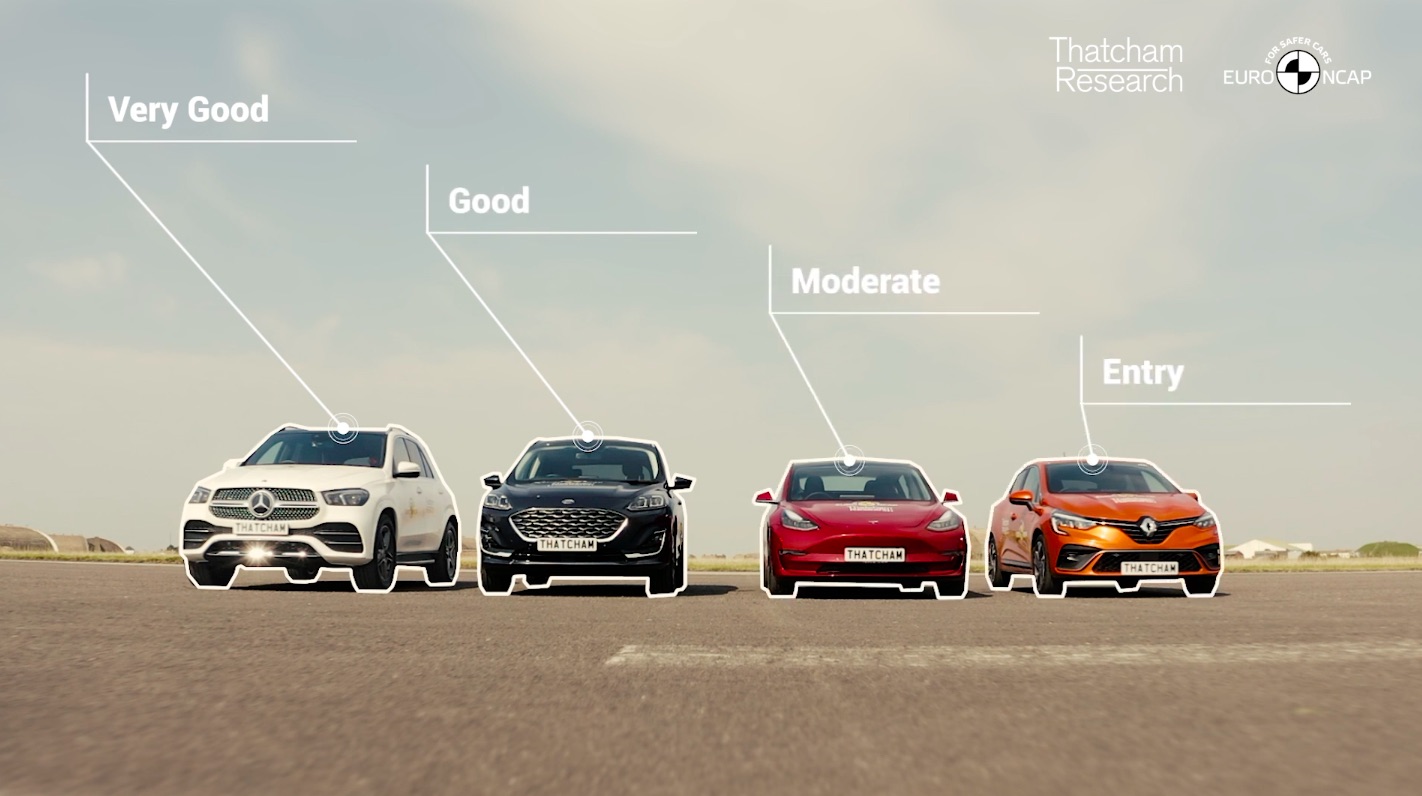
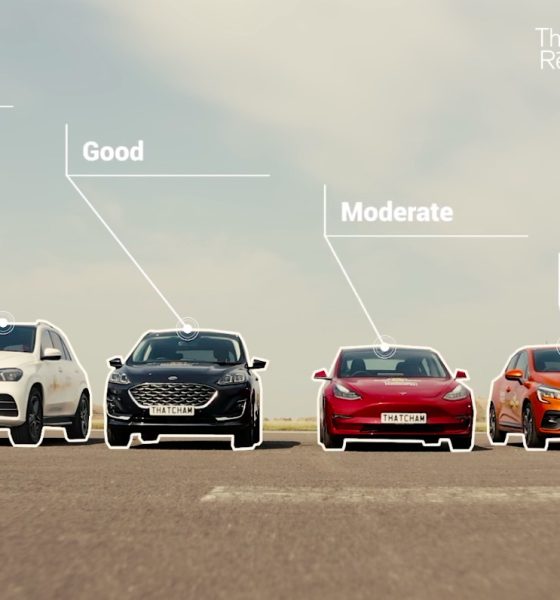
News
Tesla Model 3 gets penalized in Europe despite top scores in vehicle assistance and safety
In collaboration with Thatcham Research, the Euro NCAP has launched the world’s first Assisted Driving Grading system, a new set of metrics that are specifically designed to evaluate the driver-assist systems of cars available on the market today. For its first batch of vehicles, the firms evaluated 10 cars, from premium SUVs like the Mercedes-Benz GLE to affordable hatchbacks like the Renault Clio to all-electric vehicles like the Tesla Model 3.
As noted by Thatcham Research Director of Insurance Research Matthew Avery in a video outlining the results of the Assisted Driving Grading system’s first tests, vehicles would be graded on three metrics: the level of vehicle assistance that they provide, the level of driver engagement that they offer, and the effectiveness of their safety backup systems. The results of these tests, especially on the Tesla Model 3’s part, were rather peculiar, to say the least.
Out of 10 vehicles that were evaluated, the Tesla Model 3 ranked 6th with a “Moderate” grade, falling behind the Mercedes-Benz GLE, BMW 3-Series, and Audi Q8, which were graded as “Very Good,” and the Ford Kuga, which received a “Good” rating. This was despite the Tesla Model 3 receiving the top scores in the “Vehicle Assistance” and “Safety Backup” metrics.
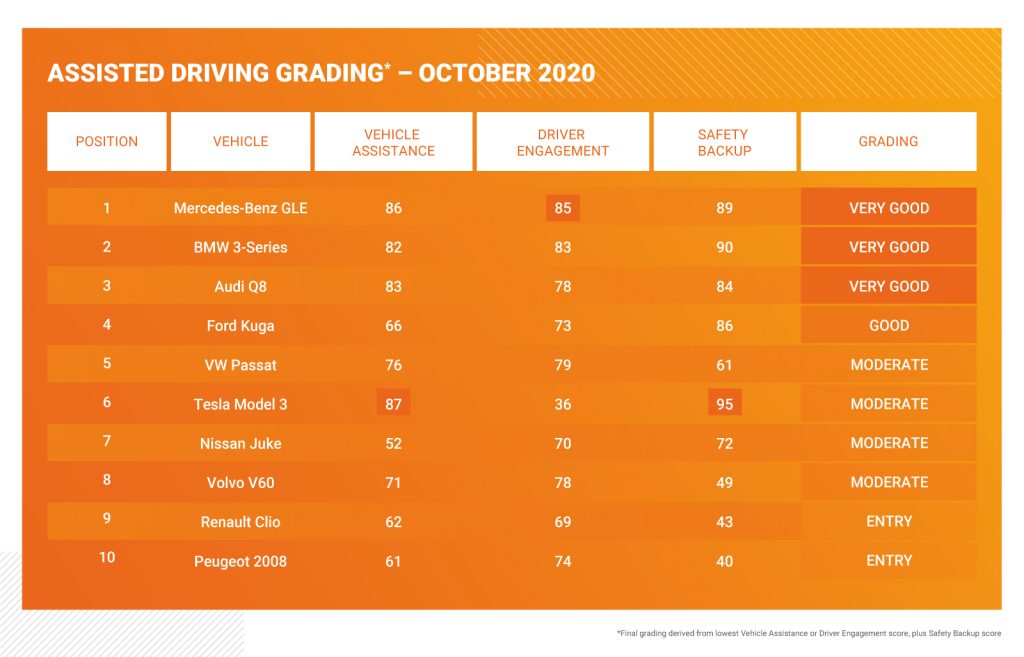
The study, for example, dubbed the Model 3 as outstanding in terms of steering assistance, with the vehicle steering itself exceptionally well through an S-shaped curve at speeds of 80, 100, and 120 km/h. Tesla’s lane change systems were also satisfactory, despite the system’s limitations in Europe. Distance control was dominated by the Model 3 as well, with the evaluators stating that Tesla’s adaptive cruise control featured a “high level of technical maturity.” From a score of 100, Tesla’s vehicle assistance received a score of 87, the highest among the cars tested.
The Model 3’s safety backup systems were also a league above its competition. As noted in a post from the Allgemeiner Deutscher Automobil-Club e.V. (ADAC), Tesla demonstrated its strengths with the Model 3’s collision avoidance systems. The all-electric sedan earned a perfect score in the firms’ tests, outperforming its premium German competition. Overall, the Model 3 received an impressive score of 95 in the Assisted Driving Grading system’s “Safety Backup” metric.
Considering these scores, one might wonder why the Model 3 ended up ranked 6th among the 10 vehicles tested by the Euro NCAP and Thatcham Research. As it turned out, this was because of the Model 3’s poor scores in the “Driver Engagement” metric, where the vehicle only earned a score of 35 out of 100. So poor was the Model 3’s scores in this metric that it was ranked last among the 10 vehicles that were evaluated.
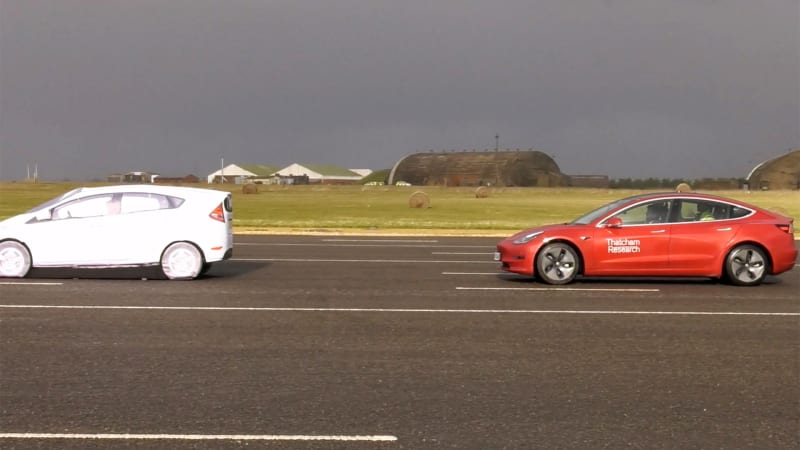
A look at the reasons behind the Model 3’s poor scores in “Driver Engagement” includes a number of interesting insights from Thatcham Research and the Euro NCAP. When testing the vehicles’ steering override functions, for example, the evaluators stated that the Model 3 resisted steering overrides from its driver. These issues were explained in the ADAC’s post.
“Should the driver make a steering movement in order to avoid an object or a pothole in the roadway, the steering assistant should allow this without resistance. In the Tesla Model 3, for example, this is not the case. Apparently, Tesla trusts the system more than its driver. The necessary cooperative assistance is not given. Instead, the Tesla system prevents its driver from attempting to intervene – it mustn’t be,” the ADAC remarked in its post.
Even more interesting is that part of the Model 3’s poor “Driver Engagement” scores was due to the term “Autopilot,” which Tesla uses to describe its driver-assist suite. The evaluators argued that the term “Autopilot” was misleading and irresponsible on Tesla’s part, and this was heavily taken against the Model 3’s rankings in the Assisted Driving Grading system.
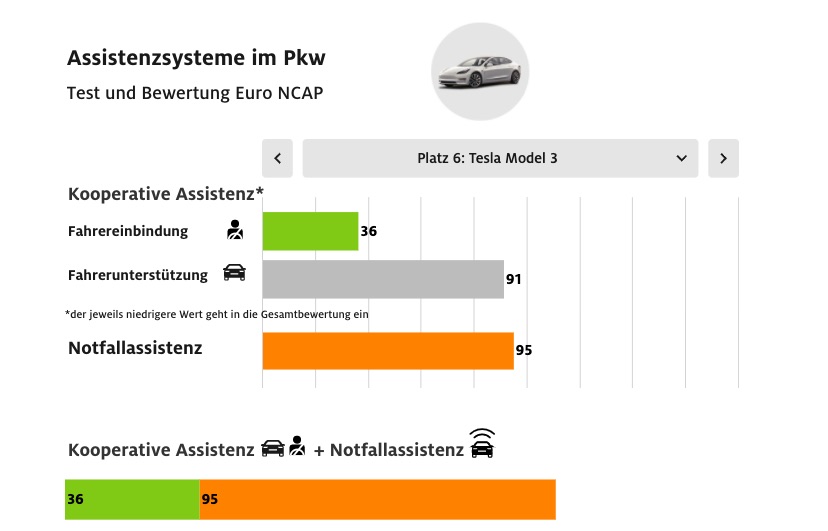
“When it comes to the first test criterion – consumer information – the Tesla Model 3 in particular fails. The assistance systems are referred to as “Autopilot” in the operating instructions for the Model 3 as well as in the sales brochures and in marketing. However, the term suggests capabilities that the system does not have in sufficient measure. It tempts the driver to rely on the capabilities of the system – which is currently not allowed by the legislature anyway. Due to its good quick-start operating aid, the Tesla Model 3 still receives 10 points,” the evaluators noted.
Ultimately, these complaints about Autopilot’s branding ended up pulling down the Model 3’s scores to the point where the all-electric sedan was ranked below the Ford Kuga. Thatcham Research Director of Insurance Research Matthew Avery explained this in a video released about the evaluation. “The Tesla Model 3 was the best for safety backup and vehicle assistance but lost ground for misleading consumers about the capability of its Autopilot system and actively discouraging drivers from engaging when behind the wheel,” Avery said.
As noted by Avery, it is pertinent for vehicles to exhibit a balance to score very well in the Assisted Driving Grading system. This was not achieved by the Model 3 despite its industry-leading backup safety systems and actual vehicle assistance tech. ADAC explained it best when outlining why the Tesla Model 3 lost to four other vehicles despite being equipped with what is noticeably the most advanced driver-assist system.
“When analyzing the test results, it is noticeable that the Tesla Model 3 has the most advanced assistance systems. With 95 points for emergency assistance (Safety Backup) and 91 points for technical assistance, it doesn’t beat the Mercedes GLE by far, but at least 11 points… Because Euro NCAP removes the many points in the area of driver support from the Tesla, because on the one hand it does not sufficiently comply with the driver’s request for a steering correction. On the other hand, because Tesla is irresponsible about the term autopilot – an even more serious reason. With only 36 points from the test area driver integration, the Tesla falls back to sixth place in the final bill,” the ADAC noted.
Thatcham Research’s overall findings could be viewed in the video below.

News
Tesla starts showing how FSD will change lives in Europe
Local officials tested the system on narrow country roads and were impressed by FSD’s smooth, human-like driving, with some calling the service a game-changer for everyday life in areas that are far from urban centers.

Tesla has launched Europe’s first public shuttle service using Full Self-Driving (Supervised) in the rural Eifelkreis Bitburg-Prüm region of Germany, demonstrating how the technology can restore independence and mobility for people who struggle with limited transport options.
Local officials tested the system on narrow country roads and were impressed by FSD’s smooth, human-like driving, with some calling the service a game-changer for everyday life in areas that are far from urban centers.
Officials see real impact on rural residents
Arzfeld Mayor Johannes Kuhl and District Administrator Andreas Kruppert personally tested the Tesla shuttle service. This allowed them to see just how well FSD navigated winding lanes and rural roads confidently. Kruppert said, “Autonomous driving sounds like science fiction to many, but we simply see here that it works totally well in rural regions too.” Kuhl, for his part, also noted that FSD “feels like a very experienced driver.”
The pilot complements the area’s “Citizen Bus” program, which provides on-demand rides for elderly residents who can no longer drive themselves. Tesla Europe shared a video of a demonstration of the service, highlighting how FSD gives people their freedom back, even in places where public transport is not as prevalent.
What the Ministry for Economic Affairs and Transport says
Rhineland-Palatinate’s Minister Daniela Schmitt supported the project, praising the collaboration that made this “first of its kind in Europe” possible. As per the ministry, the rural rollout for the service shows FSD’s potential beyond major cities, and it delivers tangible benefits like grocery runs, doctor visits, and social connections for isolated residents.
“Reliable and flexible mobility is especially vital in rural areas. With the launch of a shuttle service using self-driving vehicles (FSD supervised) by Tesla in the Eifelkreis Bitburg-Prüm, an innovative pilot project is now getting underway that complements local community bus services. It is the first project of its kind in Europe.
“The result is a real gain for rural mobility: greater accessibility, more flexibility and tangible benefits for everyday life. A strong signal for innovation, cooperation and future-oriented mobility beyond urban centers,” the ministry wrote in a LinkedIn post.
News
Tesla China quietly posts Robotaxi-related job listing
Tesla China is currently seeking a Low Voltage Electrical Engineer to work on circuit board design for the company’s autonomous vehicles.

Tesla has posted a new job listing in Shanghai explicitly tied to its Robotaxi program, fueling speculation that the company is preparing to launch its dedicated autonomous ride-hailing service in China.
As noted in the listing, Tesla China is currently seeking a Low Voltage Electrical Engineer to work on circuit board design for the company’s autonomous vehicles.
Robotaxi-specific role
The listing, which was shared on social media platform X by industry watcher @tslaming, suggested that Tesla China is looking to fill the role urgently. The job listing itself specifically mentions that the person hired for the role will be working on the Low Voltage Hardware team, which would design the circuit boards that would serve as the nervous system of the Robotaxi.
Key tasks for the role, as indicated in the job listing, include collaboration with PCB layout, firmware, mechanical, program management, and validation teams, among other responsibilities. The role is based in Shanghai.
China Robotaxi launch
China represents a massive potential market for robotaxis, with its dense urban centers and supportive policies in select cities. Tesla has limited permission to roll out FSD in the country, though despite this, its vehicles have been hailed as among the best in the market when it comes to autonomous features. So far, at least, it appears that China supports Tesla’s FSD and Robotaxi rollout.
This was hinted at in November, when Tesla brought the Cybercab to the 8th China International Import Expo (CIIE) in Shanghai, marking the first time that the autonomous two-seater was brought to the Asia-Pacific region. The vehicle, despite not having a release date in China, received a significant amount of interest among the event’s attendees.
Elon Musk
Elon Musk and Tesla AI Director share insights after empty driver seat Robotaxi rides
The executives’ unoccupied tests hint at the rapid progress of Tesla’s unsupervised Robotaxi efforts.

Tesla CEO Elon Musk and AI Director Ashok Elluswamy celebrated Christmas Eve by sharing personal experiences with Robotaxi vehicles that had no safety monitor or occupant in the driver’s seat. Musk described the system’s “perfect driving” around Austin, while Elluswamy posted video from the back seat, calling it “an amazing experience.”
The executives’ unoccupied tests hint at the rapid progress of Tesla’s unsupervised Robotaxi efforts.
Elon and Ashok’s firsthand Robotaxi insights
Prior to Musk and the Tesla AI Director’s posts, sightings of unmanned Teslas navigating public roads were widely shared on social media. One such vehicle was spotted in Austin, Texas, which Elon Musk acknowleged by stating that “Testing is underway with no occupants in the car.”
Based on his Christmas Eve post, Musk seemed to have tested an unmanned Tesla himself. “A Tesla with no safety monitor in the car and me sitting in the passenger seat took me all around Austin on Sunday with perfect driving,” Musk wrote in his post.
Elluswamy responded with a 2-minute video showing himself in the rear of an unmanned Tesla. The video featured the vehicle’s empty front seats, as well as its smooth handling through real-world traffic. He captioned his video with the words, “It’s an amazing experience!”
Towards Unsupervised operations
During an xAI Hackathon earlier this month, Elon Musk mentioned that Tesla owed be removing Safety Monitors from its Robotaxis in Austin in just three weeks. “Unsupervised is pretty much solved at this point. So there will be Tesla Robotaxis operating in Austin with no one in them. Not even anyone in the passenger seat in about three weeks,” he said. Musk echoed similar estimates at the 2025 Annual Shareholder Meeting and the Q3 2025 earnings call.
Considering the insights that were posted Musk and Elluswamy, it does appear that Tesla is working hard towards operating its Robotaxis with no safety monitors. This is quite impressive considering that the service was launched just earlier this year.








